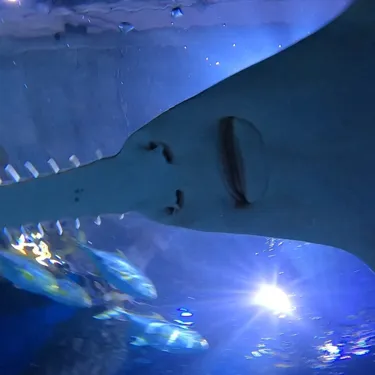Largetooth Sawfish
Largetooth Sawfish
Largetooth Sawfish have a relatively large body with an extended rostrum serated with spines that resembles a saw. Largetooth Sawfish are primarly found in estuaries and marine waters. Largetooth Sawfish grow over 6 metres in length and weigh up to 600kg.
Largetooth Sawfish are a predatory and feed on fish, molluscs and crustaceans. They can use their rostrum to stir up the sand bed or mud to find prey. More commonly, Largetooth Sawfish use their 'saw' to slash at groups of fish to stun them making prey easier to catch with their mouth.

Are they dangerous?
Largetooth Sawfish are harmless to humans. Their saw is highly sensitive and they will shy away from anything that comes close to it, rather than lashing out in defence.

Charlie enjoying some lunch
In this video you can see Charlie, a Largetooth Sawfish enjoying some afternoon lunch as she glistfully glides past an Oceanarium viewing window.
More photos

Photobombing
Charlie in infamous for being a photobomber in SEA LIFE Melbourne Oceanarium's tunnel.

Is that its face?!
The underside of a Largetooth Sawfishes head resembles a human-like face. Except what appear to be eyes are actually nostrils! The Largetooth Sawfishes eyes sit ontop of its body behind the rostrum.


Conservation status

Potential threats
- Fishing & harvesting aquatic resources
- Residential & commercial developement
Date assessed: 01 March 2013
Overall, a population reduction based on a reduction in extent of occurrence (EOO) of ≥80% over a period of three generations (i.e., 1960s to present) is inferred. Despite protection in some range states (e.g., Australia, India, Brazil, United States, Mexico; it is possibly extinct in the latter two range states), threats are ongoing and the species is assessed globally as Critically Endangered.
The Largetooth Sawfish (Pristis pristis) formerly had a widespread tropical distribution, consisting of four subpopulations (Eastern Atlantic, Western Atlantic, Eastern Pacific and Indo-West Pacific). A recent taxonomic review has shown that P. perotteti (Atlantic) and P. microdon (Indo-West Pacific) are synonymous with P. pristis and this Red List assessment replaces the previous (2006) assessments for those species. The Largetooth Sawfish is a large (6.5+ m total length) euryhaline species, with juveniles occurring in freshwater systems and adults in marine and estuarine environments (although in Lake Nicaragua, individuals spent much, if not all, of their lives in freshwater). All subpopulations have undergone significant population declines and the species is now apparently extinct in many former range states. In most others, recent records are rare (e.g., there have been very few records in the Eastern Atlantic in the last decade). In the Western Atlantic, current records indicate that Largetooth Sawfish can only be regularly encountered today in the Amazon River basin, the Rio Colorado-Rio San Juan area in Nicaragua, and possibly some remote areas of French Guiana, Suriname, and Guyana. In the Indo-West Pacific, northern Australia represents a globally important remaining population centre.
IUCN Red List